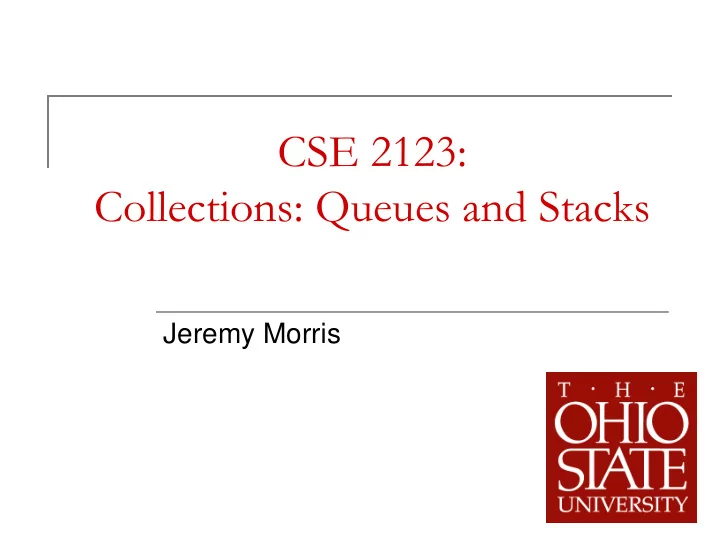

CSE 2123: Collections: Queues and Stacks Jeremy Morris 1
Collections - Queue A queue is a specific type of collection Imagine a line for a bank teller or a checkout lane at a store Contains many people But only the one at the head of the queue (line) will be leaving the queue to do anything We call this kind of processing a FIFO queue (First In, First Out) 2
Collections – FIFO Queue FIFO queue processing relies on a few standard methods: Add an object to the end of the queue: void add(E obj) Retrieve (and remove) the head of the queue E remove() 3
Collections – FIFO Queue Examine head of queue without removing it: E peek() Test to see if the queue is empty: boolean isEmpty() 4
Collections – FIFO Queue In Java, the most common implementation of a queue is the LinkedList class Similar to ArrayList class Implements both a List interface and a Queue interface Could use it like an ArrayList… …but you shouldn’t 5
Collections – FIFO Queue Circumstances determine whether to use an ArrayList or a LinkedList ArrayList more efficient for array-like operations “Constant time” to access positions at random in the list “Linear time” to add elements to front or iterate and remove elements LinkedList more efficient for queue-like operations “Constant time” to add elements to either end or iterate and remove elements “Linear time” to access positions at random in the list 6
Collections – FIFO Queue LinkedList ArrayList ArrayList – block of contiguous elements LinkedList – connected through chain of references (links) 7
Collections – FIFO Queue LinkedList Head of the list is removed for processing 8
Collections – FIFO Queue LinkedList Head of the list is removed for processing Head shifts to next node in list 9
Collections – FIFO Queue LinkedList Head of the list is removed for processing Head shifts to next node in list New nodes appended to tail of the list 10
Collections – FIFO Queue Queue properties: First node in queue is known as the head New nodes are appended to the end of the queue Use remove() to take nodes off the queue Use add() to put nodes into the queue Use isEmpty() to test to see if the queue is empty Use peek() to see the head node without removing it 11
Collections – FIFO Queues We can declare a queue by creating a new instance of a LinkedList Remember – LinkedList implements the Queue interface, so we can treat it like a Queue Queue<Integer> intQueue = new LinkedList<Integer>(); 12
Example – FIFO Queue public static void main(String[] args) { Queue<Integer> myList = new LinkedList<Integer>(); myList.add(10); myList.add(5); myList.add(22); System. out.println("LIST: "+myList); while (!myList.isEmpty()) { int head = myList.remove(); System. out.print("HEAD: "+head+" "); System. out.println("LIST: "+myList); } } 13
Practice Write a short program that: Creates three Student objects Places them into a queue Removes them in order and prints the first name, last name, and student ID of each in FIFO order 14
Collections - Stack A stack is another type of collection Imagine a stack of plates in a cafeteria We can only ever access the plate at the top of the stack To get a new plate, we take it off the top of the stack To add plates to the stack, we place them on the top of the stack We call this behavior Last In, First Out (LIFO) 15
Collections - Stack LIFO (stack) processing relies on a few standard methods: Add an object to the front of the queue: void push(E obj) Retrieve (and remove) the head of the queue E pop() 16
Collections - Stack Examine head of queue without removing it: E peek() Test to see if the Stack is empty: boolean isEmpty() 17
Collections - Stack As with, FIFO queue processing, a linked list is often used when we want to build a stack Even easier than with FIFO queue processing, since stacks only deal with the head node 18
Collections - Stack LinkedList Head of the list is removed for processing Head shifts to next node in list New nodes appended to front of the list 19
Collections - Stack LinkedList Head of the list is removed for processing Head shifts to next node in list New nodes appended to front of the list 20
Collections - Stack LinkedList Head of the list is removed for processing Head shifts to next node in list New nodes appended to front of the list 21
Collections - Stack LinkedList Head of the list is removed for processing Head shifts to next node in list New nodes appended to front of the list New first node is now the head node 22
Collections – Stack Stack properties: First node in stack is known as the head New nodes are pushed onto the front of the stack Use pop() to remove the head off the stack Use push() to add nodes onto to the top of the stack Use isEmpty() to test to see if the stack is empty Use peek() to see the head node without popping it 23
Collections - Stack We use the Stack class to instantiate a new Stack object Stack<Integer> intStack = new Stack<Integer>(); 24
Example - Stack public static void main(String[] args) { Stack<Integer> myList = new Stack<Integer>(); myList.push(10); myList.push(5); myList.push(22); System. out.println("LIST: "+myList); while (!myList.isEmpty()) { int head = myList.pop(); System. out.print("HEAD: "+head+" "); System. out.println("LIST: "+myList); } } 25
Practice Write a short program that: Creates three Student objects Places them into a stack Removes them in order and prints the first name, last name, and student ID of each in LIFO order 26
Recommend
More recommend